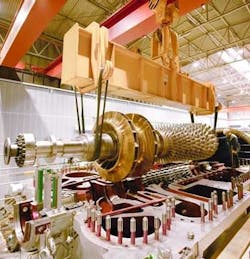Put the Right Spin on Rotating Equipment Revamps
Designers often underestimate the sizing factors for rotating machinery trains (particularly drivers), leading to installation of marginally adequate units. Then, once in service, components suffer the inevitable effects of ageing (fouling, wear and other forms of degradation). Because all elements in a train impact its operation, degradation in any component affects total performance. As a result, plants often must contend with equipment that no longer can provide sufficient capacity and, thus, has become a bottleneck. The output power limitations of compressor drivers in particular are serious issues in many cases.
Figure 1. Steam turbine is being prepared for repair and renovation. Source: Siemens.
Washing or cleaning can address some effects of ageing but can’t recover a large portion of the lost capacity. So, plants usually must consider revamping, renovating and uprating rotating machines such as pumps, compressors, steam turbines and gas turbines. Revamp and renovation projects generally include uprating drivers, re-wheeling of some compressors, installing larger pump impellers, modifying control valves and making various piping changes. In this article, we’ll look at various factors to consider in a revamp and upgrade.GETTING STARTEDFirst, conduct a performance test on the particular unit being considered for revamping or upgrading. The results can assist in defining the extent of performance degradation and the scope for upgrading; these machinery performance data also will allow you to assess the improvement provided by the renovation. Machinery upgrading usually is feasible and, indeed, routinely takes place at many chemical plants. Whenever possible, retain the existing casing and only replace the internals — rotors, impellers, diffusers and similar. (Sometimes, this is termed “re-rotoring” or “re-wheeling.”) A rule of thumb (with some exceptions) calls for changing only the internals if the cost of retrofit parts doesn’t exceed 45% of the purchase price of a new machine. The advantages of not replacing the entire machinery system are rather obvious. Only minimum changes must be made to external components such as the piping, foundation and baseplate. Also, less time is needed for getting revamp parts than for delivery of a new machine. More importantly, a revamp requires a considerably shorter shutdown (and, therefore, provides a huge production benefit). Figure 1 shows the dismantling of a steam turbine for repair/renovation. Figure 2 shows the main shaft of a compressor being removed during a revamp. A speed change possibly can upgrade both compressor/pump and driver. In some instances, replacement gearing — to give a different ratio and, thus, a speed change — will fit in the existing gearbox (gear unit) casing. Together with selective replacement of some (but not all) compressor or pump components (even selective replacement of stages), this could reduce greatly the investment, revamp project time and upgrading workload.Figure 2. Repair and overhaul of compressor requires taking the main shaft out of the casing. Source: Siemens.
AMIN ALMASI is a rotating equipment consultant based in Brisbane, Australia. E-mail him at [email protected].
About the Author
Amin Almasi
rotating equipment consultant
AMIN ALMASI is a mechanical consultant based in Sydney, Australia. He specializes in mechanical equipment and offers his insight on a variety of topics including pumps, condition monitoring, reliability, as well as powder and fluid handling and water treatment.



